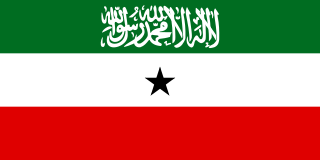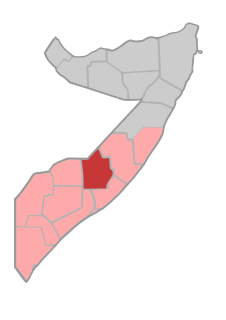
Somalia, officially the Federal Republic of Somalia (Somali: Jamhuuriyadda Federaalka Soomaaliya; Arabic: جمهورية الصومال الفيدرالية, translit. Jumhūrīyah aṣ-Ṣūmāl al-Fīdirālīyah, is a country with its territory located in the Horn of Africa. It is bordered by Ethiopia to the west, Djibouti and Somaliland to the northwest, the Gulf of Aden to the north, the Guardafui Channel and Somali Sea to the east, and Kenya to the southwest. It is separated from Socotra by the Guardafui Channel in the northeast and from the Seychelles by the Somali Sea. Somalia has the longest coastline on Africa's mainland, and its terrain consists mainly of plateaus, plains and highlands. Climatically, hot conditions prevail year-round, with periodic monsoon winds and irregular rainfall.

Somaliland, officially the Republic of Somaliland, is a self-declared state, internationally considered to be an autonomous region of Somalia.

Mogadishu, locally known as Xamar or Hamar, is the capital and most populous city of Somalia. Located in the coastal Banadir region on the Somali Sea, the city has served as an important port for millennia. As of 2017, it had a population of 2,425,000 residents. Mogadishu is the nearest foreign mainland city to Seychelles, at a distance of 835 mi (1,344 km) over the Somali Sea.

Togdheer is an administrative region (gobol) in northern Somalia, although it is de facto part of the Somaliland region, a self-declared state but internationally unrecognized.

Bari is an administrative region (gobol) in northeastern Somalia.

Nugal is an administrative region (gobol) in northeastern Somalia.

Mudug is an administrative region (gobol) in north-central Somalia.

Hiran is an administrative region (gobol) in central Somalia. Mainly inhabited by the Xawaadle,Gaalje'el clans which are a subclan of Hawiye.

Bakool is a region (gobol) in southwestern Somalia.

Lower Shabelle is an administrative region (gobol) in southern Somalia.

Benaadir is an administrative region (gobol) in southeastern Somalia. It covers the same area as the city of Mogadishu, Somalia's capital. Although by far the smallest administrative region in Somalia, it has the largest population, estimated at 1,650,227 in 2014.

Gedo is an administrative region (gobol), formerly part of the historic Upper Juba Region in southern Somalia. Its regional capital is Garbahaarreey. Gedo is a region created in 1980s and is bordered by the Ogaden in Ethiopia, the North Eastern Province in Kenya, and the Somali regions of Bakool, Bay, Jubbada Dhexe, and Jubbada Hoose further down east. The southern parts of Gedo, west of the Jubba River, used to be part of the old British Transjuba region during half of the seventy years of colonial era in Africa from 1890 to 1960. The British and Italians fought over twice in this area of Horn of Africa. Gedo region's population exploded in the last twenty years, reaching almost one million in the early 1990s after the civil war erupted in Mogadishu.

Middle Juba is an administrative region (gobol) in southern Somalia. With its capital at Bu'aale, it is located in the autonomous Jubaland region.

Lower Juba is an administrative region (gobol) in southern Somalia. With its capital at Kismayo, it lies in the autonomous Jubaland region. It has green forests and wild life animals such as lions, giraffes, hippos, crocodiles, and hyenas.

The Somali Regional State, is the largest and easternmost of the nine ethnic divisions (kilimo) of Ethiopia. The state borders the Ethiopian states of Afar, the chartered city Dire Dawa, Oromia to the west, as well as Djibouti to the north, Somalia to the north, east, and south, and Kenya to the south-west.

Greater Somalia comprises the regions in or near the Horn of Africa in which ethnic Somalis live and have historically inhabited. The territory historically encompassed British Somaliland, Italian Somaliland, French Somaliland, the Ogaden in the Ethiopian Empire, and the Northern Frontier District in the Colony and Protectorate of Kenya - at the present day, it encompasses Somalia, eastern Djibouti, the Somali region and Dire Dawa in Ethiopia, and the Lamu, Garissa, Wajir and Mandera Counties in Kenya.

The North Eastern Province is one of the former provinces in Kenya. It has a land area of 127,358.5 km², with its capital at Garissa. Previously known as the Northern Frontier District (NFD), the territory was carved out of the Jubaland region of present-day southern Somalia during the colonial period. It is and has historically been exclusively inhabited by ethnic Somalis.
The Shifta War (1963–1967) was a secessionist conflict in which ethnic Somalis in the Northern Frontier District (NFD) of Kenya attempted to join with their fellow Somalis in a Greater Somalia. The Kenyan government named the conflict "shifta", after the Somali word for "bandit", as part of a propaganda effort. The Kenyan counter-insurgency General Service Units forced civilians into "protected villages" as well as killing a large number of livestock kept by the pastoralist Somalis. The war ended in 1967 when Muhammad Haji Ibrahim Egal, Prime Minister of the Somali Republic, signed a ceasefire with Kenya at the Arusha Conference on October 23, 1967. However, the violence in Kenya deteriorated into disorganised banditry, with occasional episodes of secessionist agitation, for the next several decades. The war and violent clampdowns by the Kenyan government caused large-scale disruption to the way of life in the district, resulting in a slight shift from pastoralist and transhumant lifestyles to sedentary, urban lifestyles. Government records put the official death toll in the thousands but NGO's say more than 10,000 lives were lost.


















